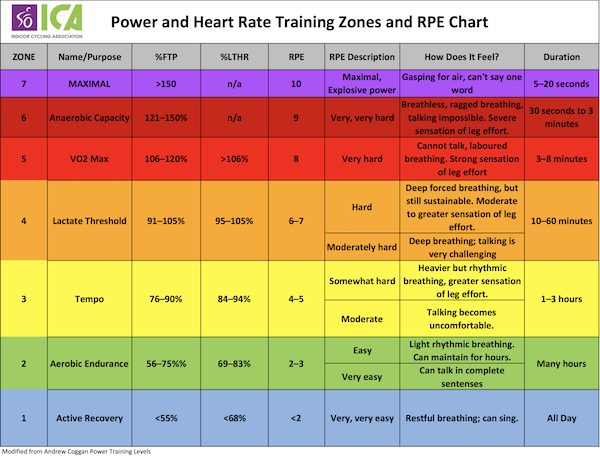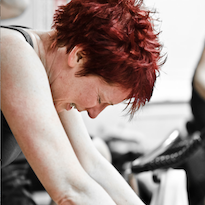In July, we posted Bill Pierce’s challenging profile “Strong Start or Fast Finish.” It’s a series of intervals that either start very hard and slightly back off to hard, or start hard and build to very hard.
Either way you do the interval, you end up spending about 3 minutes in Zone 5, with 2 minutes in low Zone 5 and 1 minute at the higher end of Zone 5.
Stacey asked a question that has likely crossed many instructors’ minds, especially if you work with a five-zone system. She asked the following:
I am new to teaching with power. I see that this profile has members staying in the red zone for 3 minutes. I was told that 2 minutes is the maximum time to stay in Zone 5 for the average rider in my classes. Please give me your thoughts. Thanks.
I’m glad she asked because I’ve had this at the back of my mind for a while. On most of our ICA profiles that refer to power zones, we use the seven-zone system, based on Dr. Andrew Coggan’s power zones. Many programs use the Coggan zones as a basis for their own. There are also quite a few who use fewer zones. How do you reconcile different zone systems?
Having more zones may add a greater level of complexity, especially with newer riders—the more numbers you have, the more people are challenged with knowing where they should be.
But I would argue that sometimes the fewer the zones, the greater the confusion—especially since the tendency to oversimplify can create too many hard-and-fast “rules.” When you have fewer zones to spread out effort, it leads people to believe that effort is a narrow range of possibilities when, in actuality, once you get above threshold, the potential output is expansive.
Functional threshold power (FTP) represents your ability to sustain the highest possible power output for 45 to 60 minutes, depending on whether you’re a trained athlete or not. The higher above your threshold you push, the shorter the amount of time you can spend there. That duration above your threshold zone—that is, in Zone 5 and above—is dependent on your current fitness and your training history. But don’t forget that a good slice is due to your genetics.
This is why zones are divided into ranges, and even then they are not black and white. Zones above threshold can be very different from one person to the next.

Above is the ICA power and heart rate training zones and RPE chart (modified from the Andrew Coggan power training levels). You can download a PDF of this chart here.
Zone 5 in this seven-zone chart is the VO2 max zone. Depending on the person, duration can be up to 8 minutes (but that would be *really* hard—elite athlete level hard). Three minutes in Zone 5 (106%–120% of FTP) is doable for most relatively fit people, especially at the lower end of that percentage.
But note that 106% of FTP can feel very different than 120% of FTP. If you want to last longer than 2 minutes, drop your output by a few wattage percentage points. Conversely, if you want to work harder—for example, 120% of your FTP—recognize that it’s normal to not last as long as you could at 110% of your FTP.
When a high-intensity training session calls for an interval in a certain zone such as Zone 5, the range allows for these differences in abilities and fitness. Your goal is to simply work hard enough so that your average output for that prescribed duration falls within that zone range. Over time, with consistent and properly performed high-intensity training, your average power will likely increase for a given supra-threshold effort, and/or the amount of time you can last at a given output will increase.
If you are at a facility that only uses five zones, then consider that your Zone 5 is a much wider zone than it would be in a seven-zone system. It encompasses all efforts above threshold, including the VO2 max zone, the anaerobic capacity zone, and the maximal neuromuscular power zone. If you are just a little bit into the red, then you should be able to endure 5, 7, 8, or maybe even 10 minutes there. As you push harder, that time spent will diminish steeply.
Circling back to Stacey’s original question, if all you can do is 2 minutes at an effort above threshold—and by the end of that 2 minutes you simply cannot go any longer, then that must mean you are working very, very hard, likely well into your anaerobic capacity zone. That’s great! But if your goal is to last longer while still being above threshold, then simply back off the effort a bit, paying attention to your power output so it doesn’t fall below threshold. Over time, you will learn how long you can last at each level above threshold.
By the way, just for clarification I asked Doyle Armstrong, master trainer for Team ICG in the UK, about their zones. While it is true they only use five colors in their Coach by Color system, they still employ seven power zones (also based on Dr. Coggan’s zones). Red, therefore, is divided into Zone 5 (duration maximum 8 minutes), Zone 6 (maximum 3 minutes), and Zone 7 (maximal effort).


The gen 1 IC7 consoles, which we have in my facility with ICG Coach By Color, only have 5 zones / colors. I was at the ICG US HQ last week to get a tour of the latest technology. The current consoles have 7 zones, complying with Coggan’s zones. Zone 5 remains standard red. Zone 6 is a red ‘circle of fire’ which is really cool to see. Zone 7 is a vortex of fire, which looks like a tornado and is amazing (and scary) to view on the console.
Since I’m still using the older console, I state that red goes from 106% of FTP to infinity and coach low red (Zone 5), medium red (Zone 6), and high red (Zone 7). People seem to understand the differences in the red zone.
this is great, thanks, Bill!